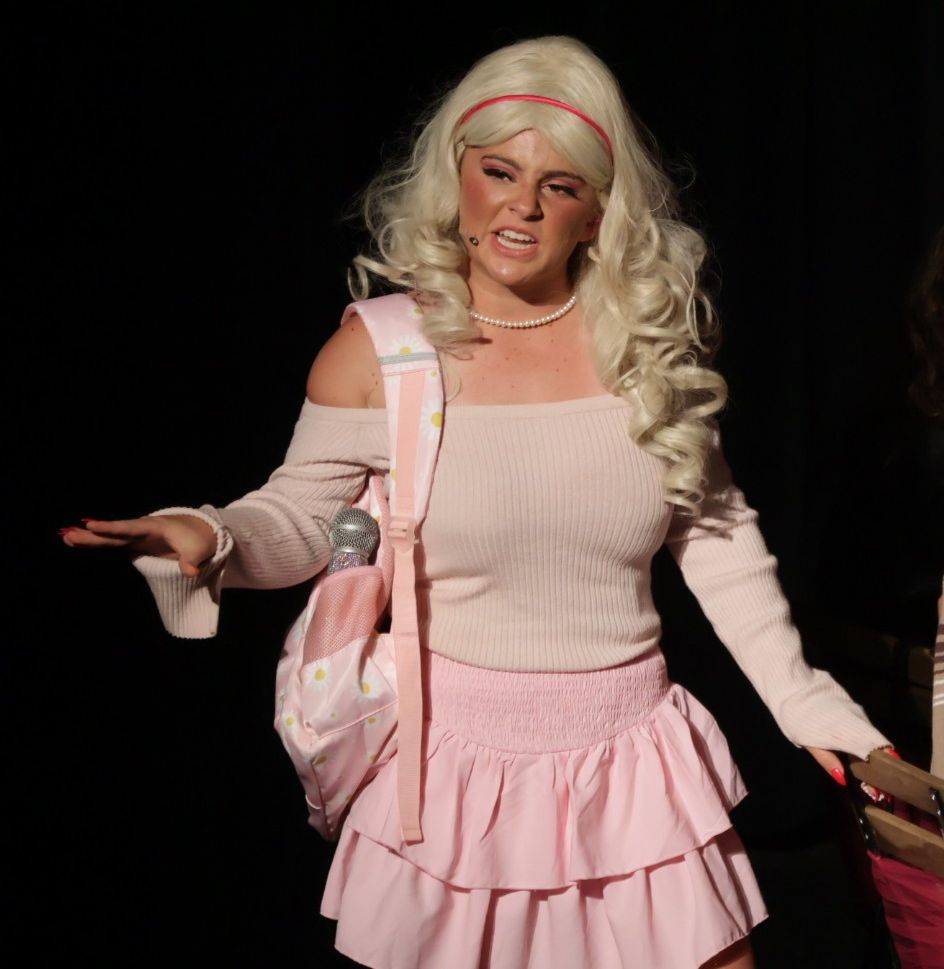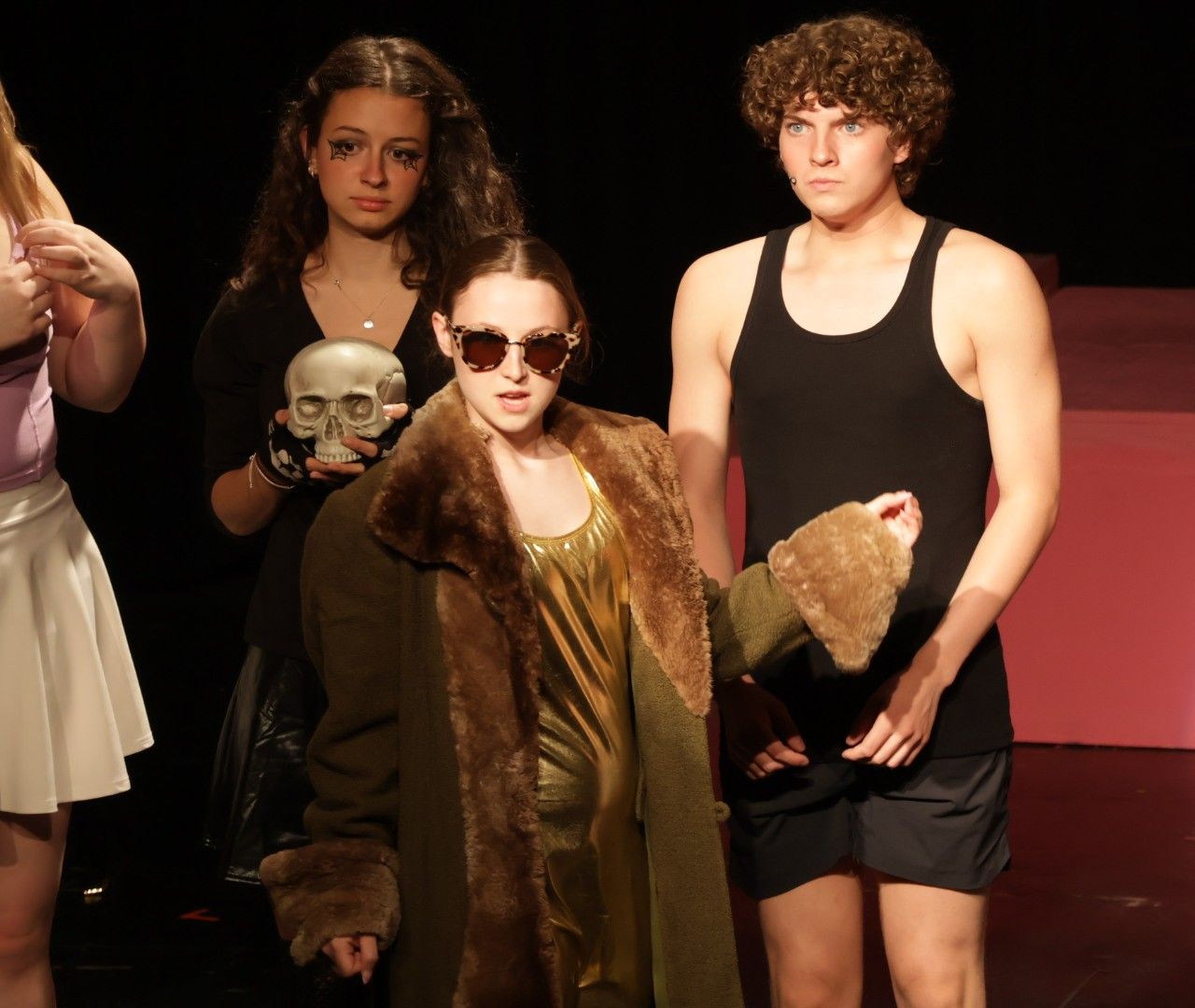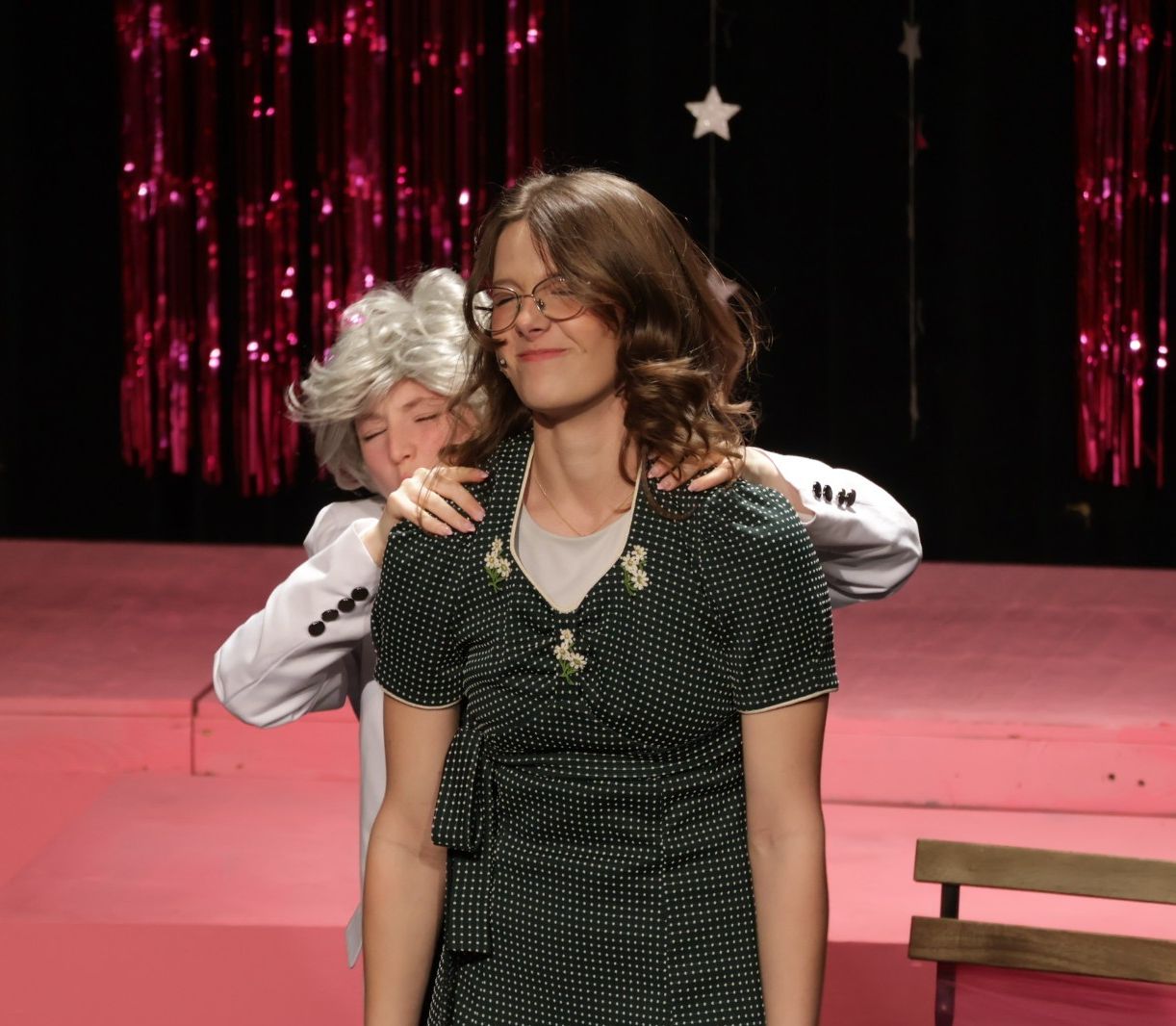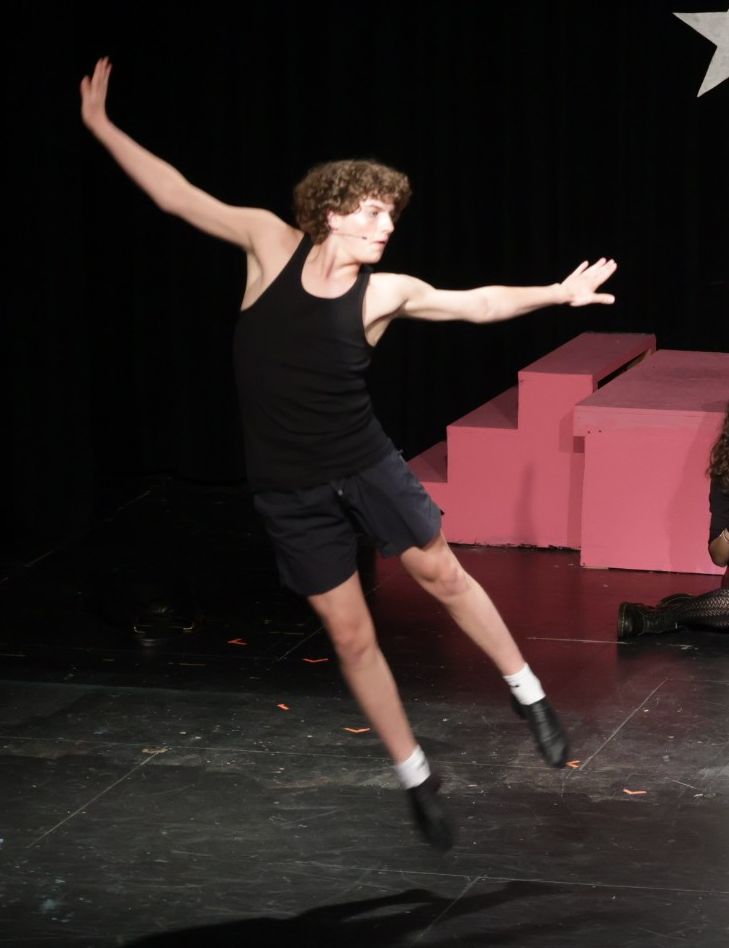Latest News
High tension after the winners of the corrupt pageant were announced. Pictured left to right, Niya Borst, Sara Huber, Richie Crane, Ella Karcheski, Sara Ireland, and Victoria Brooks.
Simon Markow
Across two nights of performances, Unwritten Show drew a crowd of over 250 people to the Housatonic auditorium for “The 37th Annual Holbrook Pageant.”
The original production was full of drama, humor and heart, showcasing what happens when students at Housatonic Valley Regional High School take the stage. From writing to directing, set design, costumes and acting, students handled every aspect of the show.

The performance used the setting of a beauty pageant to explore deeper societal issues through satire. “We wanted to speak to the stereotypes and issues that are often faced in the performance world,” co-director and production manager Alex Wilbur said. These matters included inequalities such as nepotism, gender roles and ulterior motives. The students intended to use satire as a tool for reflection, not accusation, and to push performers toward inclusivity. “We need to create a community and support each other in our endeavors, because that’s what it’s all about,” Wilbur said.

Sara Huber, the writer and co-director, said the writing process for this show was different than anything she had written before because it didn’t involve extensive planning. “I knew automatically what I wanted to write,” she said. “The message is that even when faced with something that’s corrupt, you can still find community in that and still find a way to come out of it stronger.” Wilbur noted that the creative process was rooted in personal experience. “The best ideas come from self-exploration and the themes of your own life or things happening around you,” he said.

The cast and crew were pleased with the turnout. All donations made will benefit the program in years to come. The success of this student-led initiative was meaningful to everyone involved. “It is a perfect example of our school community’s ability to create,” Wilbur said.
Actor Richie Crane, who played Nick Grain — the only male pageant contestant — was thrilled with how the production helped prepare students for the future. Passionate about dance and aiming to become a choreographer, Richie not only performed in the show but helped choreograph the cast alongside Elizabeth Forbes and Ella Karcheski. Crane got to experience firsthand what the profession might look like alongside his supportive peers. “Dancing is one of the things I love to do most,” he said. “I wouldn’t get this opportunity anywhere else.”

Another element that made the production stand out was the absence of a traditional lead role, allowing every cast member to contribute to the story equally. This was intentional. Huber said she purposely wrote an ensemble based production. “That to me is so important to the spirit of Unwritten Show because it’s really about the students coming together and making something.” The decision to avoid a lead role mirrored the show’s message of equality, a theme displayed in both the storyline and developmental process. “Everyone had their own moment to shine in the spotlight and no one person was standing out, you don’t get to see that in every musical,” Crane said.

“The 37th Annual Holbrook Pageant” was HVRHS’s third student-led production. The co-directors agreed that the Unwritten Show is more than just a production, it’s an incredible opportunity for students to explore their creativity and collaborate in meaningful ways. “It shows students that they can pursue their dreams,” Wilbur said. “It also shows teachers and professionals how hard we are working.” Ultimately, the show served as a reflection of the students’ dedication and collective effort.

Keep ReadingShow less
The group visiting the Colosseum in Rome on the spring break trip.
Ibby Sadeh
Residents of other countries outside of the United States often have preconceived notions of Americans — especially teenagers.
A group of 39 HVRHS students and chaperones from Northwest Connecticut traveled to Germany, Austria, and Italy in the span of nine days in April. As spectacular and enriching as the experience was, I couldn’t help but notice that we were judged as American tourists.
In Florence, Italy, when passing a group of European teenagers, I overheard, “oh never mind they are Americans.” I found it interesting how just by a glance in our direction it was clear we were foreigners. Some comments, however, had more negative connotations. A biker trying to weave through a crowd muttered, “annoying Americans.” This is how we are seen, as bothersome foreigners even though tourism is a big source of income for places like this. According to The Florentine, in 2015, international tourism brought 2.5 billion euros to Florence, Italy, the place that we were in for the longest time during this trip. That was a 5.2% increase from the previous year.
“Although Americans can be seen as pushy overall as a group, I have never had a problem individually, people have been very kind,” said Deron Bayer, history teacher at HVRHS, and chaperone for the recent trip.
Despite the muttered comments, I had other experiences where we had interesting conversations with foreigners. In Germany, we talked to local teenagers in Munich. They were very interested to hear about America, New York City, if we owned a house, and if we were rich. These questions about us and our lives back in America show how we are viewed.
No matter how our group was seen or reacted to, the experience of traveling internationally was incredibly influential for the students and chaperones that had the opportunity to go.

“When I grow up I want to travel and this was a good introduction to traveling internationally,” said Maddy Johnson, a junior at HVRHS who went on this trip.
The travel program EF tours packs so much into so little time — art, history, education and more. We went straight from the airport onto our coach bus with our tour guide, and to our first location in Munich.
Bayer explained why he thinks these trips are so important — “what students got to do by going on that trip was to go to a classroom that was outside of our country … you are learning about yourself and learning how to interact with different people.”
Especially because our school and community is small in size, these types of activities and opportunities have impacts on students’ school experience.
“This experience allowed me to gain new friendships with people that I had not normally hung out with in my day to day activities,” Johnson said.
Traveling brings education to the next level, offering new perspectives, although sometimes judgmental ones, and forging new connections.
“In this part of Connecticut we are very secluded, there is not much to do or see so traveling allows students to see a much broader perspective of the world,” Johnson said.
Keep ReadingShow less
Niya Borst as Penelope Pennywise, left, performing alongside Richie Crane as Old Man Strong, right, in the Housatonic Musical Theater Society production of “Urintetown” on March 18.
Ella Karcheski
Starting at the age of 2, Richie Crane has been on a stage. From dancing to acting, Crane has always been a part of the theater, acting in productions for the Sharon Playhouse, his middle school and now Housatonic Valley Regional High School. He got his moment to shine in the spotlight on March 18 when he won the Sondheim award for best supporting actor as Old Man Strong in HVRHS’s production of “Urinetown.”
Crane has been in a multitude of productions throughout his life. “I’ve been acting since I was seven,” Crane said, “but three years ago I started acting in the Sharon Playhouse, which is when I started taking it seriously.” Crane has been in the ensemble of “Prom!,” the lead actor of “Rumplestiltskin” in his middle school play, and involved in five different productions in the HVRHS theater program from the time he was in fourth grade.
Crane dances at Blue Studio in Lakeville, Connecticut.
“I have been dancing for almost two and a half years there,” Crane said, “and I’ve been looking into dance and theater as a career.” Dance is something that Crane has been involved with his whole life and continues to enjoy as time goes on. He said that “performing and dancing overall, like learning the choreography,” is his favorite part of theater.
“Presenting a story to an audience and hoping that we can demonstrate it the way it’s supposed to be while moving the audience” is Crane’s main goal when performing. Through his dance and acting, he connects himself to the audience and brings his performances to life. Earning the Sondheim meant so much, Crane said, because he feels such a close connection to theater.
“The award reminds me that all this extra work, all these dance classes are all paying off and it’s a reminder to me that I can do whatever I put my heart to,” Crane said.
The award is validation for Crane — validation for his future plans in the theater and validation that all he has done is being seen by others. Crane said he “had been working his way up to a more appreciative role” and the award makes him hopeful and fuels his passion for the next show and the achievements he can reach at the next level.
Keep ReadingShow less
The HVRHS girls tennis team consists of 17 players this year. Teammates credit the brand new tennis courts built in Summer 2024 with renewing interest in the sport.
Provided
One short year ago, the Housatonic girl’s tennis team forfeitedmultiple matches a week. With just seven girls, they couldn’t fill a full roster of 10 players. As two of those players graduated, it left the team wondering what the next season would look like, if girl’s tennis would have another season at all.
But this season the girls have taken on full sweep victories, without forfeiting a single match. What happened? Thanks to the school’s investment in the team and an onslaught of freshman players, the Housatonic girl’s team was able to go from the brink of extinction to an accomplished and close-knit group of 17 players.
This year, HVRHS installed brand new courts after taxpayers approved improvements to the school in January 2024. That upgrade brought renewed interest in the team.
While the girls only had a few wins in their Berkshire League competition, this was a huge building year for the team, captain and first-singles player Victoria Brooks said.
But Girl’s Tennis isn’t the only sport making a comeback this year. Cheerleading has returned to Housatonic for the first time since 2005, and that’s just the beginning. The 2025 spring season has been filled with major wins for Housatonic athletics. Boy’s tennis had two players become Berkshire League all-stars, and the track team has been breaking records set decades before. Boy’s Baseball and Girl’s lacrosse are on their way to states after a great season.

“It has been student driven 100%. The kids do the leg work and I just do what I can as an athletic director to support that,” said Housatonic’s athletic director Anne MacNeil. “Education-based athletics is not just about wins and losses. We are an extension of the classroom, so we base ourselves on life lessons.”
With the resurgence of so many Housatonic sports this year, it begs the question of what’s next? Could Boy’s Lacrosse or a Field Hockey team make a comeback? Or maybe something new is on the way.With a small school like HVRHS, it can be difficult to fill new teams, according to MacNeil. “If they come to me with enough numbers that make sense, then let’s go for it.”
However, it’s unlikely we’ll be seeing anything new upcoming. “Unfortunately our numbers do not really allow for new sports,” MacNeil said. “We struggled to fill JV spots – if we’re going to add sports, it takes students away from teams already established.” Despite its size, HVRHS has managed to excel athletically, largely thanks to its dedicated and determined student athletes.
Keep ReadingShow less
loading









